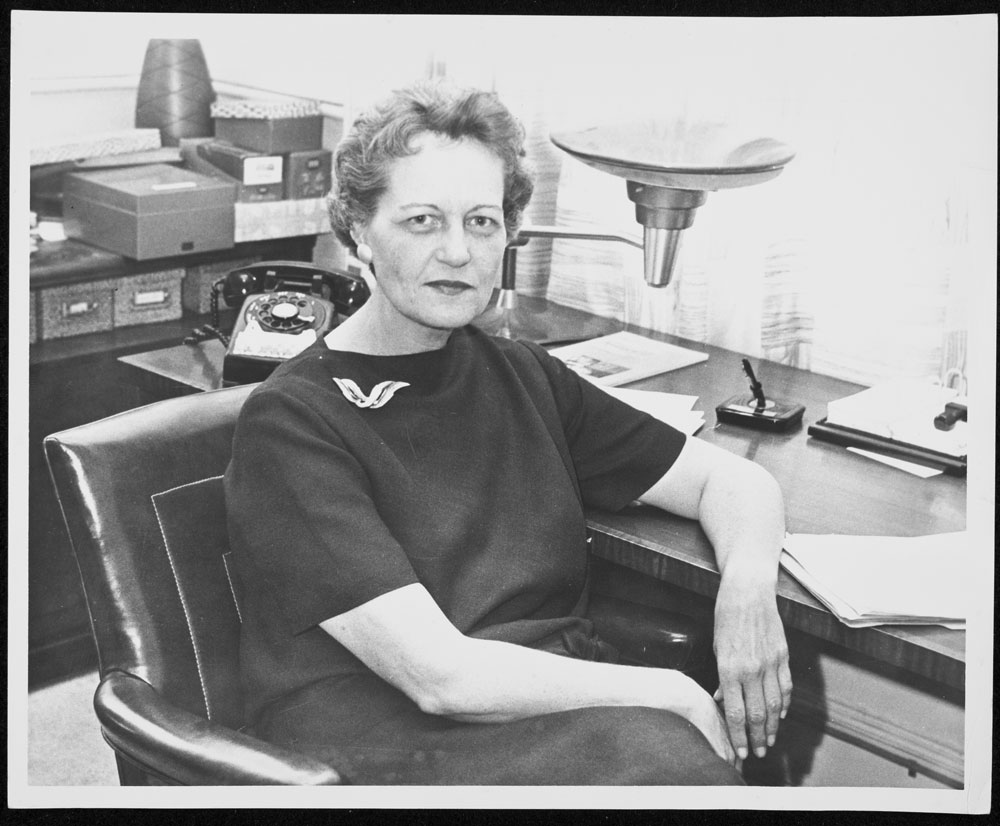| story by | |
| photos | Douglas County Historical Society, Watkins Museum of History |
| OPEN A PDF OF THE ARTICLE |
A woman ahead of her times, Emily Taylor gave the women of KU a sense of confidence and a drive to challenge stereotypes during a time when women were treated as inferior to men.

Emily Taylor: Woman of Impact
Note: Much of the information in this article is from “Experimental Autonomy: Dean Emily Taylor and the Women’s Movement at the University of Kansas,” by Kelly Sartorius, published in Kansas History: a Journal of the Central Plains, Spring 2010.
Emily Taylor served as the Dean of Women at the University of Kansas (KU) from 1956 until 1974. In this position, she encouraged women students to look beyond their traditional concerns about dorm hours, social events and traditional feminine careers to greater personal independence and intellectual growth. She had a lasting impact on students at KU and across the nation in her position as Director of the Office of Women in Higher Education at the American Council on Education. While serving in this position, she helped establish a national program to identify women qualified to be high-level university administrators. She was viewed as a leader of educators by supporting forward-looking women’s organizations, including those focused on the status of women.
Taylor was working at Miami University in Ohio at the time she was offered the position. Her negotiations for the job gave a clue about how she would approach the position. When Chancellor Franklin Murphy initially offered her the position of dean of women, Taylor was interested in the position because of Murphy’s progressive views on the involvement of students in their own governance. He emphasized that student personnel positions should encourage student achievement, develop leadership skills and foster personal growth. However, she was to be subordinate to Laurence C. Woodruff, who had recently been given the title Dean of Students instead of Dean of Men. Taylor refused to accept the current organization chart and requested that she report directly to the chancellor. Murphy agreed that Taylor would report to him without going through the dean of students. This allowed women (Taylor) a role in the administration at KU. In addition, reflecting Murphy’s support for an independent role for the dean of women, Taylor’s salary was $8000 per year, $1300 more than the Dean of Men. She was also able to increase her staff. She began with one assistant in 1957, but by 1975, she supervised 11 employees and a graduate assistant. Meanwhile, the dean of men’s office depended on graduate assistants for its activities.
Through her career at KU, Emily Taylor supported initiatives that focused on women’s independence and their intellect. She was setting the agenda rather than the female students themselves. Her work with the Association of Women Students changed the focus from using rules and disciplinary action to women being more independent and in control of their lives.
Taylor wanted women’s living groups and the female students to take an active role in determining their own social standards. This was at a time when in loco parentis—the idea that university administrators would set rules that mimicked those established by parents before the women went to college—was practiced. At KU, the Associated Women Students (AWS) governed dorms and sorority houses by adopting closing hours, regulations that set hours for “men’s calling hours,” the hours women could visit men’s living quarters, and establishing a procedure for “late permission” to return after the normal closing hours. At the time Emily Taylor arrived on campus, residence halls dealt with minor infractions, while the AWS had a judiciary board to deal with more serious cases. Safety of women students was the rationale for all these rules, but if administrators were candid, they admitted that the primary purpose of these regulations was to limit time male and female students were unsupervised in order to enforce social behavior to prevent premarital sex.
Taylor indicated she was interested in the position at KU because the AWS reported only to the dean of women and the chancellor. She wanted her staff to encourage student leaders to influence and to help make university policy. She believed the females involved in women’s student government would develop leadership skills while allowing women to define their own policies. Taylor wanted female students to determine their own programming by bringing in lecturers who questioned the status quo for women in universities and encouraged them to become autonomous by developing personal behavioral standards and the confidence to apply them in their own lives without an authority dictating their personal actions, according to “Experimental Autonomy: Dean Emily Taylor and the Women’s Movement at the University of Kansas,” by Kelly Sartorius.
Taylor reorganized the AWS and established two committees: Bright Women to research KU alumnae with careers and Roles of Women to exam women’s place in society. She also changed the judiciary board to a board of standards because she wanted to downplay the disciplinary actions of the AWS. Instead, she encouraged women’s dorms and other living units to resolve the student problems that occurred. To be inclusive of all females attending the university, she expanded the prevue of the AWS to include even those living off campus. One student compared Taylor’s interaction with students as the student being a post and Taylor a pile driver. Taylor did not intend to provide traditional advice about boyfriends. In an interview with Sartorius on June 4, 1998, Taylor explained her no nonsense views.
- I warned them that my advice would be very unconventional and that I had no sympathy for many things. … [One] young woman said she wanted to talk about … this awful story about this fellow that she was dating [who]was treating he so badly and [she]just went on and on. And I said … no I didn’t say anything for awhile, I just listened. And then she said, “What do you think I should do?” And I said, “Well, I think you should get yourself another man.”
Taylor took her guidance of the AWS to a personal level by meeting with the president of the AWS Senate at her home every Sunday. She hosted receptions for AWS members and an annual overnight retreat. Anne Hoopingarner Ritter, AWS president during the 1960-61 school year, explained that Taylor asked women to think about their role in society and their reasons for attending the university. She had the women explain their plans after they graduated and expected them to consider options beyond being a wife and mother.
A sit-in by a group a women called the February Sisters in 1972 illustrated that Taylor’s ideas were taking hold. These women held a peaceful, 13-hour sit-in at the East Asian Studies Center. After meeting with university administrators including Chancellor Laurence Chalmers , the “sisters” reported they had achieved one of their goals with an announcement that a woman would chair the university’s affirmative action program. Other demands included a free day care center financed by KU. Other concessions included the appointment of a woman as vice chancellor for academic affairs, a woman administrator in the financial aid office, an autonomous women’s studies department and a women’s health program.
Though all of her accomplishments would be hard to include, Emily Taylor’s influence cannot be ignored. The following is taken from a “Tribute to Emily,” written by Casey Eike in July 1995, and provides an excellent summary of how she was viewed by her students.
- Emily gave us what no one else could at the time, a belief in ourselves and in our abilities, a self-confidence we never had, even a belief that we could change the world. All that, and the chance to prove to ourselves and to others that we were becoming leaders. And, once leaders, she helped us to find our own way of challenging the usual, the stereotypes, the way it has always been. And when we were unsure and hesitant about our ability or talent, Emily would sigh, “Well,” and quote, “They said it couldn’t be done … so I didn’t even try.” Such recitation would shame us into forging ahead with our particular project or challenge, and once again we would prove to ourselves that, yes, I can do this. With her guidance, her witty nuances, her sometimes acid remarks, we finally saw the world and our place in it in a new way. And we would never be the same.
- A woman among women. A mentor’s mentor. A role model which we knew we could never match. We thank you, Emily, for all that you are and all that we have become.




